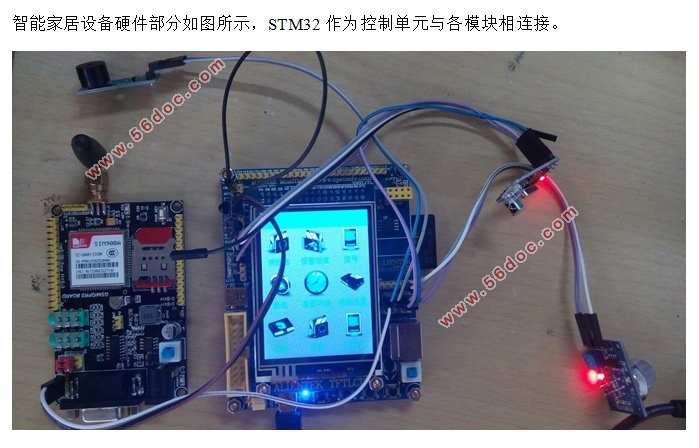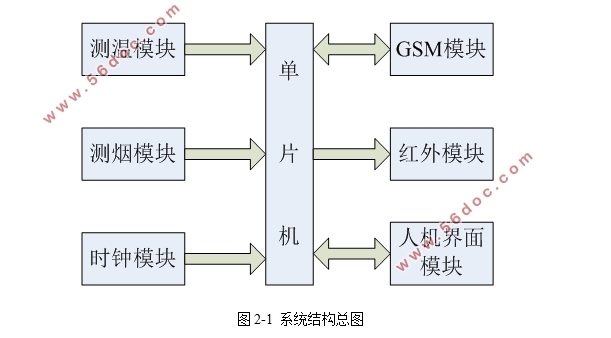基于STM32的智能家居设备设计(任务书,开题报告,论文12000字)
摘 要
智能家居,同时也称为家居自动化。其目的是利用技术提高生活质量,因此随着生活水平的提高,受到越来越多人们的欢迎。智能家居设备的设计利用对家用电器、通信系统、报警系统等的集中控制,改善用户在安防、控制、节能及保健方面的体验。设计旨在通过智能家居设备的应用,带给人们更加方便快捷、安全放心的生活环境。
设计使用STM32单片机作为主控制器,TFT触摸屏作为人机界面,通过温度、烟雾的实时监控和无源蜂鸣器的控制做出报警处理,利用红外编码控制红外家电,使用GSM模块在优化报警处理的同时,实现打电话、发短信等通信功能,保证设备功能的多样性。
关键词:智能家居 STM32 TFT触摸屏 GSM 红外控制
The design of smart home equipment based on STM32
Abstract
Smart home,also known as home automation. Its purpose is improving the quality of life by using technology.With the improvement of living standards,smart home is welcomed by more and more people.The design of smart home equipment improves the user experience in security, control, energy saving and health care by centralized controlling household appliances, communication systems, alarm systems, etc.. The design aims to bring people more convenient and safer living environment through the application of smart home equipment.
The design uses STM32 microcontroller as the main controller, TFT touch screen as man-machine interface, through the real-time monitoring of temperature, smoke and the control of passive buzzer make alarm processing, using infrared coding control infrared appliance, using GSM module in the optimization of the alarm processing at the same time, to achieve a call, send text messages, and other communication functions. Ensure the diversity of equipment function.
Key Words: Smart Home;STM32;TFT Touch Screen;GSM;Infrared Control


目 录
摘要 I
Abstract II
第一章 绪论 1
1.1 智能家居的背景 1
1.2 智能家居的研究现状 1
1.3 智能家居的系统设计 1
1.4 本文的内容安排 2
第二章 系统方案分析与选择论证 3
2.1 系统方案设计 3
2.1.1 单片机方案 3
2.1.2 测温模块方案 3
2.1.3 测烟模块方案 3
2.1.4 时钟模块方案 4
2.1.5 通信模块方案 4
2.1.6 遥控方案 4
2.1.7 显示模块方案 5
2.1.8 控制模块方案 5
2.1.9 蜂鸣器方案 6
2.2 系统最终方案 6
第三章 智能家居设备的硬件设计 7
3.1 STM32单片机主控系统电路设计 7
3.2 数据采集模块 8
3.2.1 器件介绍 8
3.2.2 测温模块电路 8
3.2.3 测烟模块电路 9
3.3 时钟模块 9
3.3.1 RTC实时时钟特性 9
3.3.2 工作原理 9
3.4 GSM通信模块 10
3.4.1 SIM900A特性 10
3.4.2 GSM通信模块电路 11
3.5 红外模块 11
3.5.1 红外遥控特性 11
3.5.2 二进制信号调制 11
3.5.3 红外发射模块电路 12
3.6 触摸显示模块 13
3.6.1 TFT触摸屏特性 13
3.6.2 TFT触摸屏电路 13
3.7 蜂鸣器 14
3.7.1 蜂鸣器介绍 14
3.7.2 蜂鸣器电路 14
第四章 智能家居设备的软件设计 15
4.1 软件开发环境 15
4.2 各功能程序设计 15
4.2.1 程序流程概述 15
4.2.2 程序流程框图 16
4.2.3 测温模块 17
4.2.4 测烟模块 17
4.2.5 实时监控 18
4.2.6 GSM通信 19
4.2.7 红外遥控模块 20
4.2.8 触摸显示模块 21
4.2.9 蜂鸣器 23
4.2.10 铃声功能 24
第五章 系统调试、分析与结果 26
5.1 硬件电路基本调试 26
5.2 分模块、分功能调试 26
5.2.1 测温模块的检测调试 26
5.2.2 测烟模块的检测调试 26
5.2.3 时钟模块的检测调试 27
5.2.4 GSM通信模块的检测调试 27
5.2.5 红外遥控模块的检测调试 27
5.2.6 触摸显示模块的检测调试 27
5.2.7 蜂鸣器的检测调试 28
5.2.8 监控功能的检测调试 28
第六章 总结与展望 29
6.1 总结 29
6.2 展望 29
致 谢 31
参考文献 32
附录一 原理图 34
附录二 硬件实物图 35
附录三 系统运行界面 36
|





